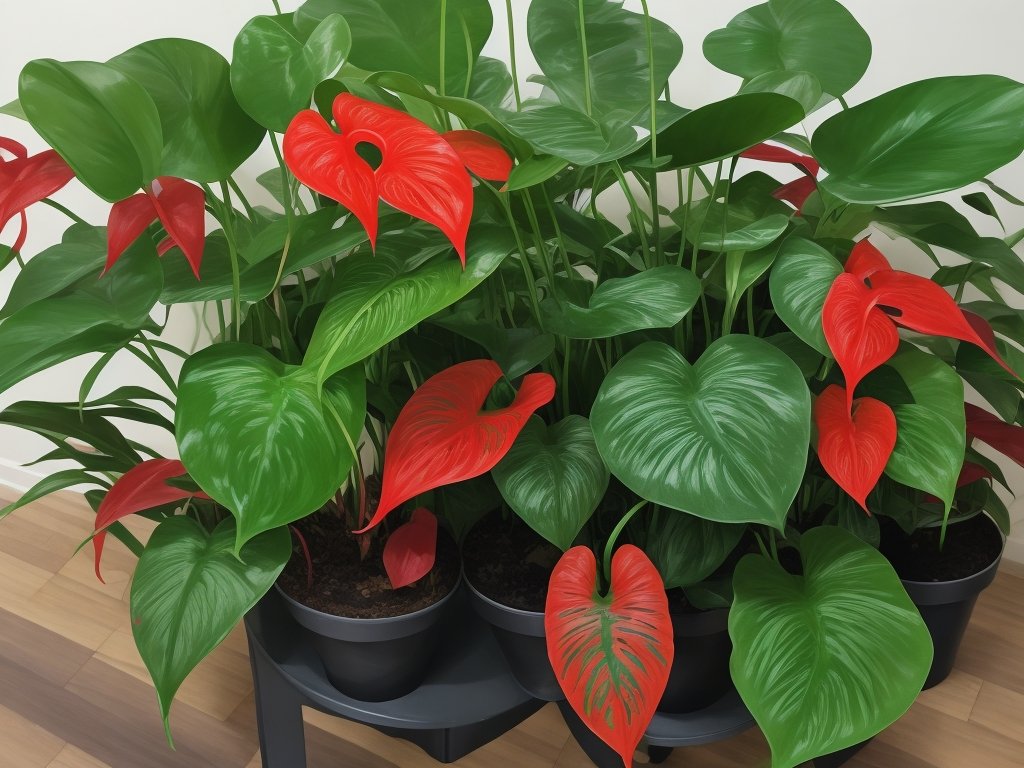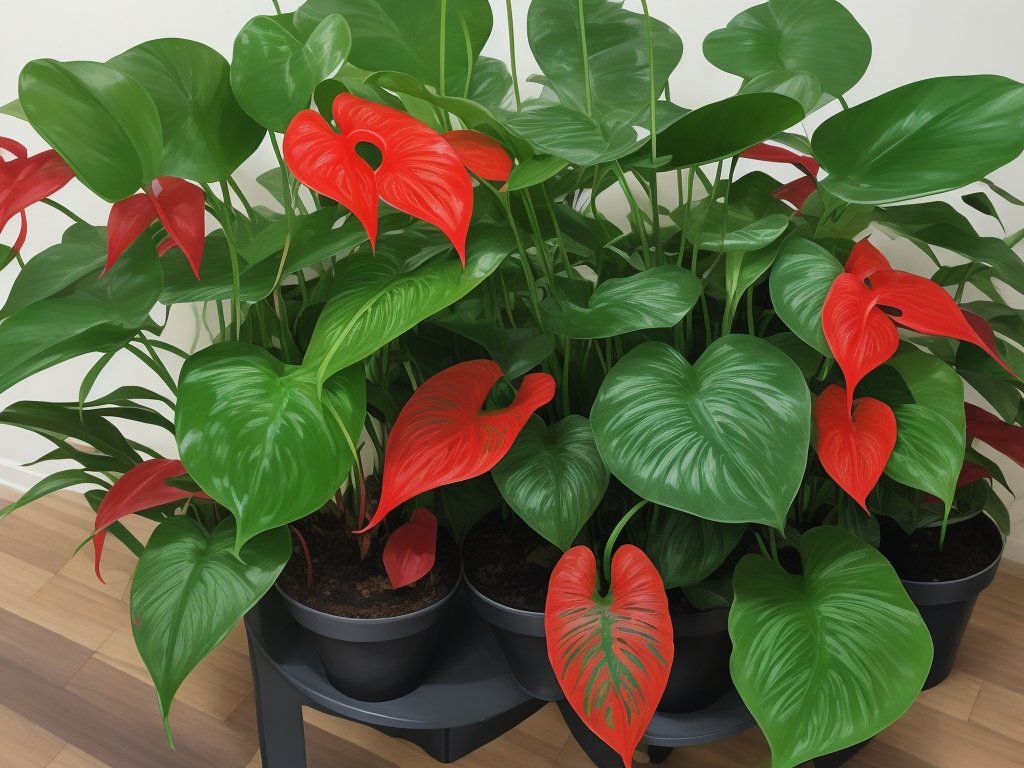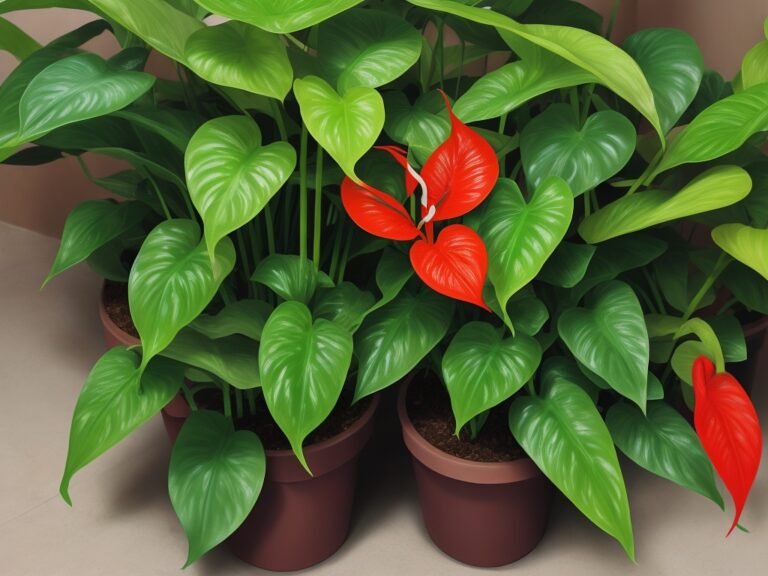Anthurium And Companion Plants: Perfect Green Partners!
Key Takeaways:
- Anthurium thrives when paired with plants that have similar humidity and light requirements.
- Companion plants like ferns and bromeliads can enhance the aesthetic appeal of an Anthurium arrangement.
- Careful selection of companion plants can help create a balanced ecosystem that reduces pest and disease risks.
- It’s important to consider the growth patterns and space requirements of anthurium and companion plants to ensure they can coexist harmoniously.
Are you looking to add a touch of elegance to your garden or indoor space?
Look no further than Anthurium plants and their perfect companions.
These stunning plants with their glossy leaves and vibrant flowers are a popular choice for plant enthusiasts everywhere.
But did you know that pairing Anthurium with the right companion plants can enhance their beauty and create a harmonious environment?
In this article, I will walk you through the benefits of using companion plants, how to choose the right companions for Anthurium, care tips, and even troubleshooting advice.
Whether you’re a seasoned gardener or just starting out, get ready to take your plant game to the next level!
| Plant Type | Sunlight Requirement | Watering Needs | Soil Type |
|---|---|---|---|
| Anthurium | Indirect sunlight | Regular watering | Well-draining soil |
| Pothos | Low to moderate sunlight | Low watering | Well-draining soil |
| Snake Plant | Low to moderate sunlight | Low watering | Well-draining soil |
| Peace Lily | Indirect sunlight | Regular watering | Well-draining soil |
What is Anthurium?
Anthurium is a beautiful flowering plant that is known for its vibrant, heart-shaped blooms.
Popular varieties of Anthurium
Popular varieties of Anthurium include the Anthurium andraeanum, known for its heart-shaped red flowers, and the Anthurium clarinervium, with its striking dark green leaves and prominent white veins. Other popular varieties include the Anthurium crystallinum, Anthurium warocqueanum, and Anthurium veitchii.

Benefits of using companion plants
Using companion plants in your garden provides increased biodiversity, natural pest control, and increased pollinator activity.
Increased biodiversity in the garden
Increased biodiversity in the garden is important because it supports a healthier ecosystem.
It promotes natural pest control, attracts more pollinators, and enhances the overall balance of the garden.
By choosing diverse companion plants, you can create a thriving habitat for various organisms and foster a more sustainable and resilient environment.
Natural pest control
One of the benefits of using companion plants is natural pest control. Certain plants release chemicals or emit scents that repel pests, helping to keep them away from your Anthurium and other plants.
This can reduce the need for harmful pesticides and promote a healthier, more balanced garden ecosystem.
Some companion plants that are known for their pest-repelling properties include marigolds, garlic, and basil. Additionally, attracting beneficial insects like ladybugs and lacewings can help control pests naturally.
Increased pollinator activity
Increased pollinator activity refers to a greater number of pollinators, such as bees, butterflies, and birds, visiting the garden. This is beneficial for plants, including Anthurium, as it enhances pollination and leads to better fruit and flower production.
Adding companion plants can attract and support a diverse range of pollinators, boosting the overall activity in the garden.

Choosing companion plants for Anthurium
To choose companion plants for Anthurium, consider plants with similar environmental requirements and those that complement Anthurium’s aesthetic.
Plants with similar environmental requirements
Plants with similar environmental requirements to Anthurium include ferns, bromeliads, peace lilies, pothos, and orchids.
These plants thrive in similar light, temperature, and humidity conditions, making them ideal companions for Anthurium.

Plants that complement Anthurium’s aesthetic
Plants that complement Anthurium’s aesthetic include ferns, bromeliads, peace lilies, pothos, and orchids. enhance the beauty of Anthuriumh habits, foliage colors, and textures that enhance the beauty of Anthurium.
Mixing these plants creates a harmonious and visually appealing arrangement.
Best companion plants for Anthurium
Anthurium pairs well with ferns, bromeliads, peace lilies, pothos, and orchids.
Ferns
Ferns are excellent companion plants for Anthurium due to their similar environmental requirements and complementary aesthetics.
They thrive in the same light and humidity conditions as Anthurium, making them easy to care for together.
Anthurium’s vibrant flowersn backdrop to Anthurium’s vibrant flowers, creating a visually appealing display.
Some popular fern varieties to consider are maidenhair fern, Boston fern, and bird’s nest fern.
Just make sure to provide consistent watering and avoid overwatering to keep both plants happy.
Bromeliads
Bromeliads are excellent companion plants for Anthurium.
They have similar environmental requirements and complement Anthurium’s aesthetic.
They add a variety of colors, textures, and heights to your garden.
Bromeliads also help increase biodiversity, naturally control pests, and attract pollinators.
It’s important to consider their watering, light, temperature, and spacing needs for optimal care.
Peace lilies
Peace lilies (Spathiphyllum) are excellent companion plants for Anthurium.
They thrive in similar environmental conditions, making them easy to care for together.
Peace lilies add beautiful, glossy foliage and elegant white flowers to complement Anthurium’s vibrant blooms.
Their ability to purify the air is an added bonus.
Pothos
Pothos, also known as Devil’s Ivy, is a popular companion plant for Anthurium.
It has trailing vines and heart-shaped leaves that can beautifully complement Anthurium’s foliage.
Pothos is easy to care for and can thrive in various light conditions, making it a versatile choice.
Its low maintenance needs and ability to tolerate slightly dry conditions make it a great companion for Anthurium.
Plus, Pothos can help improve air quality by removing toxins from the environment.
Just remember to water it when the top inch of soil feels dry, and provide bright, indirect light for optimal growth.
Orchids
Orchids are a beautiful and diverse group of flowering plants.
They come in a wide range of colors, shapes, and sizes, making them a popular choice for indoor and outdoor gardens.
Orchids are known for their elegant and exotic flowers, which often bloom for several weeks or months.
They require specific care techniques, including proper watering, light requirements, and temperature considerations.
With the right care, orchids can thrive and add an enchanting touch to any garden or home.
Care tips for Anthurium and companion plants
Proper watering techniques include keeping the soil slightly moist and avoiding overwatering.
The Anthurium plant and its companion plants thrive in bright, indirect light.
Temperature and humidity wise, they prefer warm conditions with moderate humidity levels.
Proper watering techniques
Proper watering is crucial for Anthurium and its companion plants.
Water deeply, allowing the soil to dry slightly between waterings.
Avoid overwatering, as it can lead to root rot.
Use well-draining soil and ensure adequate drainage.
Adjust watering frequency based on the plant’s specific needs and environmental conditions.
Observing the plant’s leaves and soil moisture levels can help determine when it needs watering.
Light requirements
Anthurium plants thrive in bright, indirect light. They prefer a balance between sunlight and shade, so placing them near a north or east-facing window is ideal.
Avoid exposing them to direct sunlight, as it can scorch their leaves.
If the light is too low, the plant may not flower or grow properly.
Temperature and humidity considerations
Anthurium plants prefer temperatures between 60-80°F (15-27°C) during the day and slightly cooler temperatures at night. They thrive in high humidity levels of around 60-80%.
Consider placing a humidifier or misting the leaves regularly to maintain the ideal moisture levels.
Avoid placing Anthurium plants in drafts or near heating or cooling vents as it can affect their temperature and humidity needs.
Creating a harmonious Anthurium and companion plant arrangement
Creating a harmonious Anthurium and companion plant arrangement involves balancing heights and textures, mixing colors and foliage types, and following placement and spacing guidelines.
Balancing heights and textures
When arranging Anthurium and companion plants, balancing heights and textures is key.
Aim for a mix of tall, medium, and short plants to create visual interest.
Contrast smooth leaves with textured foliage or bold blooms.
Weaving different heights together creates a harmonious and dynamic display.
Mixing colors and foliage types
Mixing colors and foliage types is important for creating an eye-catching and harmonious Anthurium and companion plant arrangement.
Consider using a combination of contrasting or complementary colors to add visual interest.
Mix plants with different foliage textures, such as glossy and matte leaves, for added variation.
Don’t be afraid to experiment and have fun with different combinations to find what works best for your personal taste.
Placement and spacing guidelines
To ensure a harmonious arrangement, place Anthurium and companion plants at a proper distance from each other.
Aim for a spacing of 6-12 inches between each plant.
This allows ample room for growth while preventing overcrowding.
Consider the growth habits and sizes of the plants when determining placement.
Arrange them in a way that creates visual balance and allows each plant to receive adequate light and air circulation.
Common issues and troubleshooting
So, you’ve encountered some issues with your Anthurium plants.
Let’s dive into common problems and how to troubleshoot them.
Overwatering and root rot
Overwatering can lead to root rot in Anthurium plants. This happens when the roots are constantly saturated, preventing them from getting enough oxygen.
To avoid this, make sure to only water when the top inch of soil is dry.
And ensure that the pot has proper drainage to allow excess water to escape. Additionally, avoid using saucers to catch water underneath the pot, as this can lead to waterlogging.
Pests and diseases
Pests and diseases can be a common issue for Anthurium plants. Some common pests include aphids, mealybugs, and spider mites.
These can be controlled by using insecticidal soap or neem oil.
Diseases such as root rot can be prevented by not overwatering and ensuring proper drainage. Regularly inspecting your plants and addressing any issues promptly is key to keeping them healthy.
Nutrient deficiencies
Nutrient deficiencies can occur in Anthurium plants if they don’t receive the necessary nutrients. Signs of deficiencies include yellowing leaves, stunted growth, and poor flowering.
To remedy this, you can provide balanced fertilizer or use specific fertilizer blends formulated for Anthuriums.
It’s important to follow the recommended dosage and application instructions to avoid overfertilization, which can also harm the plant. Additionally, ensuring that the soil pH is within the appropriate range can help optimize nutrient uptake.
Frequently Asked Questions
Can Anthurium be grown outdoors?
Yes, Anthurium can be grown outdoors in certain climates. It prefers warm and humid conditions with filtered sunlight.
Make sure to protect it from direct, intense sunlight and cold temperatures.
Anthurium can thrive as a beautiful addition to your outdoor garden or patio.
Can I plant Anthurium with other potted plants?
Yes, you can definitely plant Anthurium with other potted plants! Anthuriums are versatile and can thrive alongside various companion plants. Just make sure the plants have similar environmental requirements and complement Anthurium’s aesthetic.
Some great companion plants for Anthurium include ferns, bromeliads, peace lilies, pothos, and orchids.
Just remember to consider watering techniques, light requirements, and temperature and humidity considerations for both Anthurium and its companions.
How often should I fertilize Anthurium and its companion plants?
To keep both your Anthurium and its companion plants thriving, fertilize them every 2 to 4 weeks during the growing season, which is typically spring and summer.
Use a balanced, water-soluble fertilizer and follow the package instructions for dilution ratios.
Adjust the frequency if your plants show signs of nutrient deficiencies or over-fertilization.
And always remember to water your plants before fertilizing to prevent root burn.
Keep an eye on their growth and adjust as needed.
Final Verdict
Anthurium plants can benefit greatly from the addition of companion plants in their environment. Choosing companion plants that have similar environmental requirements and aesthetic qualities can create a harmonious arrangement.
The presence of companion plants increases biodiversity, provides natural pest control, and encourages pollinator activity.
Proper care techniques, such as proper watering, light requirements, and temperature considerations, are crucial for the health of both Anthurium and its companion plants. By following these tips and troubleshooting common issues, gardeners can create a beautiful and thriving Anthurium and companion plant arrangement.





